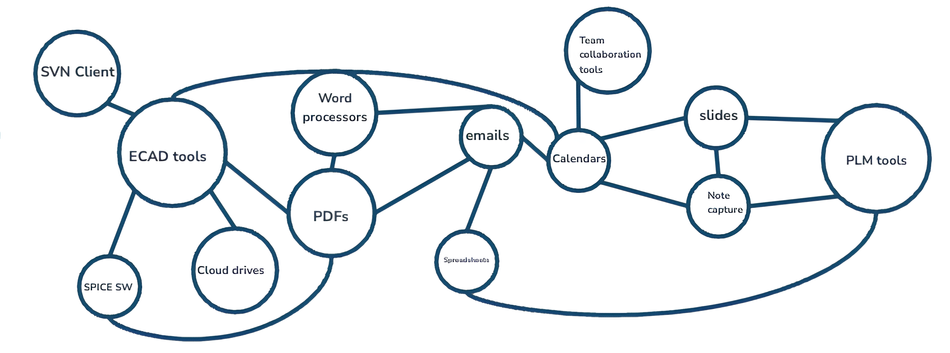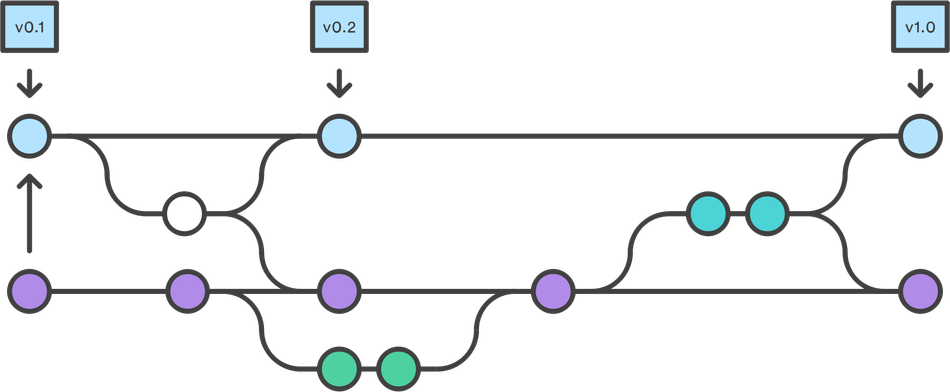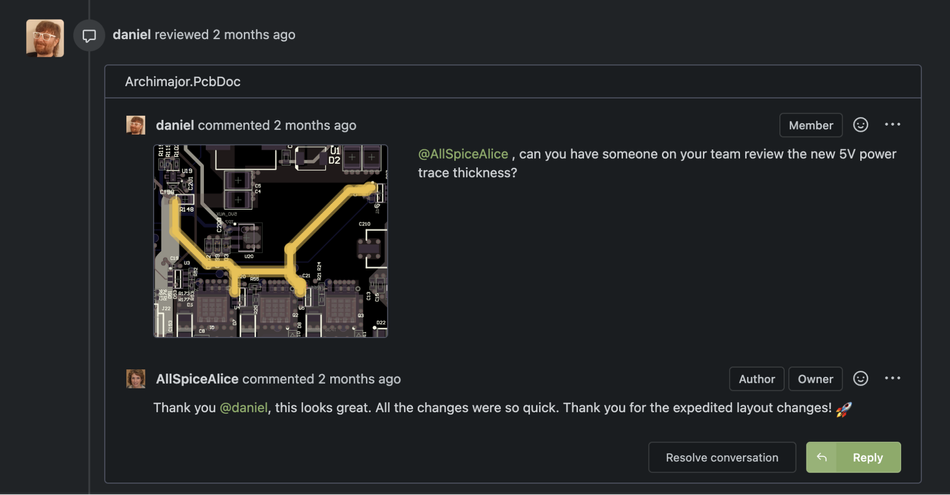The Future of Hardware Development: Collaborative tools and techniques
The fragmented nature of traditional hardware development tools calls for the adoption of a unified, technology-driven approach that integrates robust version control systems like Git alongside methodologies similar to agile and DevOps to streamline processes and enhance team collaboration.
Introduction
Ever wondered how collaboration could transform hardware development? In an industry where precision, reliability, and scalability are critical, the arrival of collaborative tools is not just an improvement—it's a revolution. Enter AllSpice.io, a pioneering platform designed to bridge the gap between the tried-and-tested methodologies of software development and the specific needs of hardware engineering.
AllSpice allows the hardware developer community to harness the power of advanced version control systems like Git, which have long been the backbone of software development. This integration brings a new era of collaboration, reducing errors, speeding up development cycles, and fostering innovation by connecting minds and ideas in ways previously deemed impractical.
This article is the first in a series exploring how platforms like AllSpice reshape hardware development. This series will explain the benefits of adopting software-centric approaches, discuss strategies for managing large-scale projects, and illustrate how embracing these tools can lead to unprecedented growth and efficiency in hardware engineering.
This article is part of The Future of Hardware Development, a series featuring insights into how cutting-edge collaborative platforms transform traditional hardware development workflows, integrating advanced version control systems and paving the way for more efficient, error-free project management.
Explore other articles from this series:
- The Future of Hardware Development: Collaborative tools and techniques
- Learning from Git: The Role of Software Practices in Hardware Development
- Implementing Git for Hardware in 30 Days: Insights from the E-Book by AllSpice
- Scaling Hardware Projects with Git: Strategies for Large Team Management
- Silos to Synergy: Encouraging Cross-Disciplinary Teamwork in Hardware Development Teams
Challenges in traditional hardware development
Traditional hardware development is characterized by a more linear and isolated approach. In this process, hardware engineers and pcb designers typically work in distinct phases without continuous integration of changes or updates. Each team member may work on separate components of the hardware, using manual methods to track changes and document versions, often through physical logs or localized digital files.
Communication between team members is generally handled through meetings, phone calls, or emails. This can lead to delays in sharing important updates, resulting in inefficiencies and the potential for errors when integrating different components of hardware projects.

Managing different revisions and dealing with conflicts in design changes becomes cumbersome. Hardware engineers manually merge changes, which can lead to oversight and discrepancies in the final product. Testing and debugging also become more challenging as tracking the origin of errors is difficult without a clear record of changes.
Overall, the traditional hardware development process is slow, with higher risks of project delays and increased costs due to less efficient communication.
Understanding version control in hardware development
Version control has historically enabled software developers to manage changes to source code systematically, ensuring traceability and facilitating collaboration. Its significance extends beyond mere file management; it serves as an audit trail for the project lifecycle, a necessity equally applicable to hardware development.
Hardware design without version control
In hardware design, the absence of version control can lead to numerous operational inefficiencies. Common issues include version confusion, where team members inadvertently work on outdated designs or worse, overwrite each other’s progress. Miscommunication is another frequent challenge, compounded by the physical nature of hardware designs that cannot be "merged" as easily as lines of code. These problems are exacerbated in environments that rely on manual tracking systems, leading to data loss and significant delays in project timelines.
Adapting version control for hardware
Adapting hardware version control requires rethinking its application to accommodate the unique needs of physical product development. Unlike software, hardware development processes involve multiple dimensions of change management, including iterative physical prototypes and their corresponding digital representations. This complexity necessitates a robust system that handles diverse file types, from CAD designs to electrical schematics.

These systems must support large binary files and provide tools that allow engineers to visualize differences between file versions, a crucial feature often taken for granted in software development. Moreover, the integration of these systems with hardware-specific tools and platforms ensures that all components of a product's development are synchronized and documented.
Benefits of version control in hardware
The benefits of employing version control in hardware development are manifold. It enhances traceability, allowing teams to track every change made to a design file and understand the reasoning behind each decision. Furthermore, hardware version control fosters a collaborative environment by facilitating a clear and structured workflow. Engineers can work in parallel without the risk of conflicts, speeding up the development process while maintaining the integrity of the design.
The shift towards collaboration in hardware development
In hardware development, traditional, siloed approaches are increasingly considered outdated and inefficient. As projects escalate in complexity and scale, integrating collaboration tools has become critical to streamline processes and bridge the gaps between different engineering disciplines.
Limitations of traditional hardware design
Traditionally, hardware development teams often operate in isolation, focusing on specific components without a unified view of the entire project. This isolation can lead to duplicated efforts, inconsistencies across components, and significant delays in project timelines. A common issue in such environments is the misalignment between physical prototypes and their digital counterparts, resulting in costly and time-consuming revisions.
Emergence of collaborative tools
The digital transformation in manufacturing and design has brought in a new set of collaborative tools. These tools leverage advanced technologies like cloud computing and real-time data synchronization to allow for the real-time sharing, updating, and management of design files. This shift facilitates a more dynamic workflow and supports a more integrated approach to hardware development.
Benefits of collaborative hardware development
Collaborative tools significantly enhance efficiency by enabling real-time updates and feedback, which reduce the cycle time from design to production. They also improve accuracy and consistency across various stages of development, helping to prevent errors that stem from miscommunication. Moreover, collaborative environments foster innovation and creative problem-solving by bringing diverse perspectives together, which is essential in developing cutting-edge hardware solutions.
AllSpice: integrating hardware development with Git
Integrating software version control systems like Git into hardware development processes marks a pivotal advancement in the field. AllSpice is a hardware development platform for hardware engineers, PCB designers, and electrical engineers that harnesses this powerful idea to bring agile and DevOps practices with unprecedented efficiency and collaboration to hardware projects.

Why Git for hardware?
Git has revolutionized software development by enabling multiple developers to work simultaneously on the same project with minimal conflicts. This system, primarily designed for managing code, can also be adapted to handle the complex file structures and binary files commonly found in hardware development.
AllSpice’s unique adaptation
AllSpice takes the core functionalities of Git and tailors them to the specific needs of hardware engineers. This adaptation involves enhancing Git’s capability to handle large binary files and providing intuitive tools that allow hardware developers to visualize changes in designs, much like software developers view code differences.

Core features of AllSpice
Version control for hardware designs: AllSpice enables precise tracking and management of changes in hardware designs, ensuring that every modification is recorded and retrievable.
Collaborative design reviews: With integrated tools for commenting and discussion, AllSpice allows teams to conduct thorough design reviews in real-time, enhancing the quality and accuracy of the final product.
Integration with various tools: AllSpice seamlessly integrates with popular ECAD tools like KiCAD, Altium, OrCAD, Allegro, and more, allowing engineers to use familiar software while benefiting from enhanced version control and collaboration features.
By integrating these features, AllSpice streamlines the workflow and significantly enhances collaboration among team members. It enables hardware teams to work in parallel without the risk of overwriting each other’s work.
The implementation of AllSpice in hardware projects brings a level of organization and efficiency that parallels what has been achieved in software development for years. It simplifies the complex process of managing hardware designs, ensures greater accuracy, and fosters a collaborative environment essential for innovation in today's hardware industry.
Visit AllSpice’s official website today to explore how the platform can streamline your hardware development process.
Conclusion
The traditional hardware development process, characterized by a patchwork of specialized but isolated tools, presents substantial challenges. These include disjointed data management, communication breakdowns, and inefficient workflows, which collectively hinder project progress and amplify the risk of errors. The difficulties in maintaining consistency across various platforms create a necessity for a more integrated approach.
By embracing a unified platform that consolidates all aspects of hardware development, teams can enhance collaboration, streamline operations, and improve overall project outcomes. This shift not only optimizes the development cycle but also positions teams to better meet the demands of increasingly complex projects, ensuring that innovation continues at a brisk pace without sacrificing quality or efficiency.
This series highlights how tools like AllSpice revolutionize hardware development, merging robust version control with dynamic collaboration capabilities. As we've explored, AllSpice enhances efficiency, reduces errors, and fosters innovation across diverse teams.
Download the eBook, 'Implementing Git in 30 Days,' to start transforming your hardware development process today.


